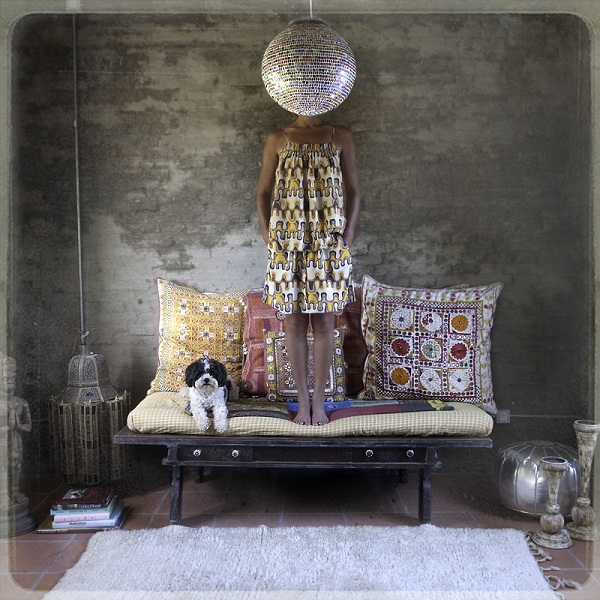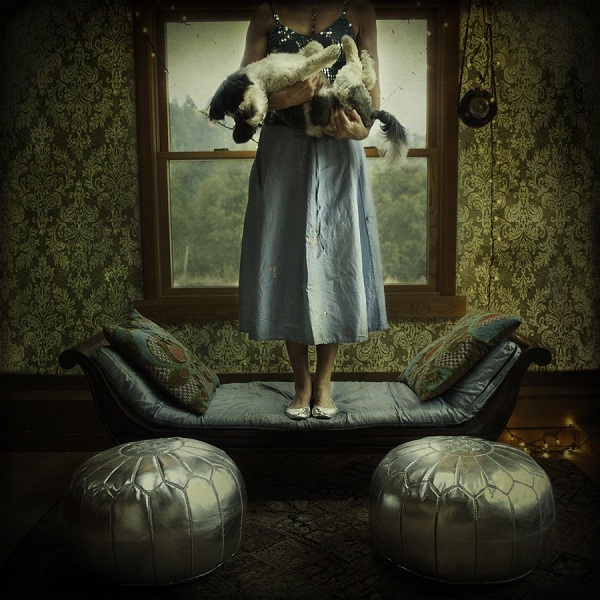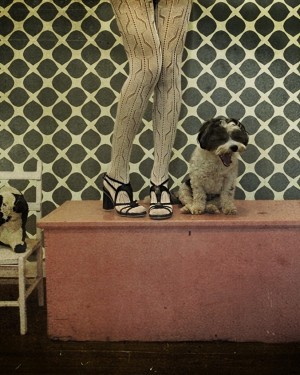Artist of the Week 8/15 – 8/21: Heidi Lender Peels Away the Layers of Self-Discovery
Bubba, a five-year-old Bichon-Shitzu mix, is made for the camera. He stares off with a serene, faraway look, lazes on elaborate carpets and furniture, or just doggy smiles for the camera. Sometimes he even yawns!
But it’s evident that being an accessory in Heidi Lender’s Once Upon photography series has its advantages, besides being the trusted companion of the photographer. Posing for photos is no small feat when your owner’s self-portrait series attempts to merge fashion and interior design in an exploration into her inner self.
High standards are expected from a favorite pet whose owner once wrote features for high-end national magazines, while traveling throughout both Paris and New York — the fashion meccas. So, Bubba, chin up please! Thank you.
“He’s an incredible listener,” Lender says of Bubba, admitting that she’s not sure how she got him to be attentive in her shots, but concedes that he was used as an adornment in her portraits.
Obedience aside, Bubba’s presence adds character to Once Upon, a self-imposed weekly assignment that had only three rules: “stand on a bench, make sure it’s Monday, and wear something pretty.” The 42 photos feature Lender, 46, headless in various indoor and outdoor locales exploring herself through clothes from her own closet.
The California native dresses her body in skirts, sheath dresses, patterned stockings and bare legs, all while standing on trunks, high chairs, couches, chaise lounges, center tables, ottomans, and even in an old trailer. Sometimes, she even wields a shotgun or a hatchet!
The photos appear textured and dated, like a favorite family heirloom on a bookshelf, something that forces you to stop and investigate further. Lender herself embraced this analogy, giving up writing about fashion to study yoga in India, where she lived part-time.
“I worked for W Magazine on staff for five years in the Paris and New York offices, and freelanced after that for everyone from Vogue and Elle Décor to Los Angeles Magazine, Brides, and Travel & Leisure,” Lender said. “I left the publishing world to study yoga in Mysore, where I lived part-time for eight years.”
In 2010, she traveled to Haridwar, a district in the northern part of India near the border with Tibet, to learn to shoot pictures with a group of photographers during the Kumbh Mela, a festival celebrated by Hindu pilgrims.
“I was always into photography. But in 2009, I really stepped into the arena when I bought my first digital SLR,” she said.
In Haridwar, she “spent days with the naga babas, the most interesting and the main players of the Mela.” The naga babas, also called sadhs or spiritual nomads, participate in the ritual bathing in the river where the Mela festival is held. It is said that the river holds the essence of achieving liberation, the fourth and final stage of life.
Recently, Lender took a road trip through the southwest U.S. and captured a beautiful photo of a sunrise in the middle of the highway.
“I left Eureka, Nevada before sunrise, a long haul back to the [San Francisco] Bay area on [highway] 80. The sun was coming up, the road was empty, the scene beautiful and serene.”
Much like her long drive, the view from Lender’s lens can be quirky and imaginative. Her Once Upon project is a fusion of fashion and self-discovery; a tribute to what life is and what it could be.
GALO: In your Once Upon series all of your portraits are headless. You explain that it added a level of obscurity and freedom from identification. I sense that you wanted to shift the focus from your face to the fashion aspect of your self-expression. Was this the reason you excluded your face?
Heidi Lender: The idea has little to do with shifting focus from face to fashion, but rather, [it] gives the viewer an opportunity to focus on an idea instead of a person. I’ve taken the [I] — the ego — out to make a point about identity. The viewer is able to also project his/her own thoughts, ideas, and impressions onto the image without getting lost in a traditional portrait of a “person” — eyes, expression, facial features.

One of the 42 untitled photos from the series “Once Upon” created by Heidi Lender. Photo Credit: Heidi Lender.
GALO: Some photos have more color and texture than others, especially the photo where you appear to be standing on a bed, in brown calf-high boots. There are many multi-colored cushions on the bed head and the walls have a crispy appearance like an old photo. Is this symbolic of the mood you were in that day?
HL: Every self-portrait I make, I suppose, is reflective of the mood I am in at that moment. On the other hand, I may have been composing this “set” for a while in my head, and decided to execute it on that day. This series developed more in that way (the latter) than any other series I’ve produced.
GALO: Your guidelines for this project included standing on a bench, and in many photos your sense of design and fashion come through. I especially love the wooden chaise lounge with the blue satin seating that you stand on. Why was standing on something of importance to this project?
HL: The project was born from a Flickr group, in which I participated, called Bench Monday, whose guidelines I continued to follow and adopt. The “bench,” or whatever I chose to stand on, developed into a symbolic platform, if you will, on which to launch a particular identity, style, personality.

One of the 42 untitled photos from the series “Once Upon” created by Heidi Lender. Photo Credit: Heidi Lender.
GALO: You explain that you investigate a host of different personalities, the ones that you hide or show to others through fashion and design. What personalities did you discover about yourself through this project?
HL: Ever a fashion hound, when I was little, I would wake up and lie in bed before dressing for school, and ask myself, “Who do I want to be today?” all the while scanning my closet in my mind. I would pick out my outfit before my feet hit the floor — preppy, sexy, nerdy, prissy, or punky. I have been playing with the expression of personalities for as long as I can remember dressing myself. This project was more about playing than discovering.
(Article continued on next page)

